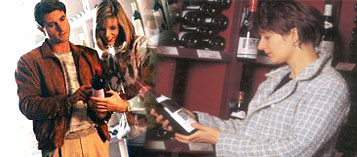

A shop may display hundreds of wines from around the world. Choosing a bottle is easier if you remember that most wines fall into one of several main style groups.
The wine lover today has an enormous range of wines from which to choose. A wine store in a big cosmopolitan city may sell the produce of 20 or even 40 countries. Even in winemaking countries, which traditionally have drunk local wine, the mass-market stores increasingly scour the world for the novel, the good-value, the excellent. With this plethora of choice come new and often unfamiliar ways of labeling wine, even of describing wine, to confront the consumer.
Wines differ according to origin, grape variety, technique of manufacture and age. Origin is the most important clue to a wine's character, and the biggest section of this book, Wine Lands of the World, describes winemaking countries and regions, the wine styles made, and what they taste like. The grape variety used in a wine has assumed major importance since New World wine lands such as California and Australia burst upon the scene. These lands generally label and name their wine according to the name of the grape, a trend that has spread back to Europe, where it was previously rarely seen apart from in Italy, German and Alsace. Winemaking techniques have changed dramatically since 1960, and have a chapter to themselves. Finally, the age of a bottle of wine has an important bearing on its character. The chapter on wine and time explains why age matters, and the charts in the reference section of this book offer a guide to the recent vintages. When choosing a bottle of wine that you intend to drink in the near future — rather than keeping it to improve in the bottle — your first consideration should be the occasion on which you intend to open it. Do you want a cool thirst-quencher or a wine to sip and savour? Do you want an everyday wine for an informal occasion, or a serious bottle for an important dinner? Choosing wine to match food is discussed in a separate chapter; the greatest food and wine partnerships are those where the flavours of the dish match the character of the wine.
So much choice can be daunting, but with a little help a structure falls into place, and the world's wines become both accessible and enjoyable. In the next few pages we offer a resume of wine styles, grouped by colour and character.
|
|
|



